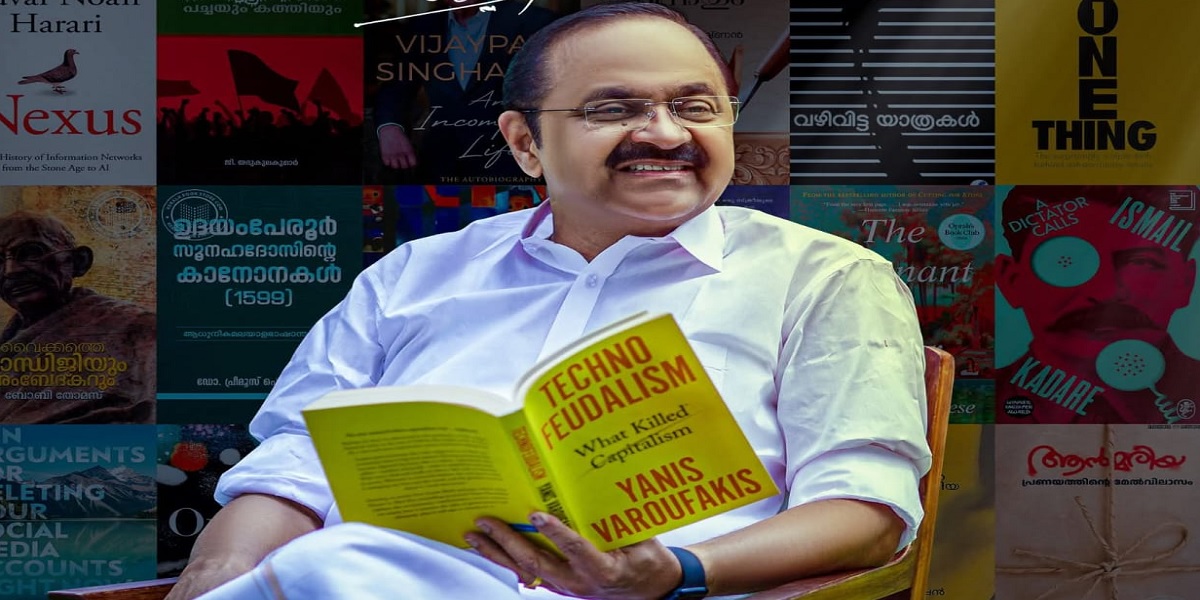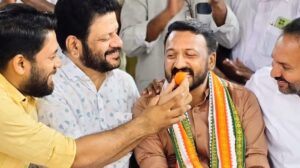The real story of Nilambur is that of VD Satheesan. He took bold risks that could have cost him dearly had the outcome been different. But with this resounding victory, he has not only silenced his critics — he can now rightfully dream of staking his claim to the Chief Minister’s post.
Published Jun 24, 2025 | 9:00 AM ⚊ Updated Jun 24, 2025 | 9:00 AM

Beyond the numbers, the real story of Nilambur is V.D. Satheesan. He took bold risks that could have cost him dearly had the outcome been different.
Synopsis: The UDF may have won Nilambur after nearly a decade, but it is VD Satheesan who stands to benefit the most – after all, he took the greatest risk. Though not a candidate himself, Satheesan’s leadership faced a defining test, one he could ill afford to fail. Had Shoukath lost, criticism would likely have centred on Satheesan, given his principled stand regarding PV Anvar. But with this resounding victory, he can now rightfully dream of staking his claim to the Chief Minister’s post.
Nilambur, the land of teak and forest treasures, has returned to the Congress-led UDF after nine years. In Monday’s crucial by-election, UDF candidate Aryadan Shoukath defeated CPI(M)’s M Swaraj by a significant margin of 11,077 votes, marking a clear political shift in the region.
The seat, long held by the UDF, had slipped away in 2016 when PV Anvar, backed by the LDF as an independent candidate, broke the Congress monopoly.
He retained it in 2021, but his recent fallout with the CPI(M) and subsequent resignation triggered the by-election.
Anvar, running as an independent this time, polled 19,650 votes, showing that his personal support base remains strong. BJP candidate Mohan George finished far behind with 8,648 votes.
The UDF’s dominance was evident across the constituency, securing leads in 7 out of 8 local bodies, including the Nilambur Municipality. Only in Karulai Panchayat did the LDF manage a narrow lead of 307 votes.
The coalition had begun its preparations months in advance. The candidate was announced early, and all booth committees were activated well ahead of the election.
More than 400 family meetings were held. A list of 4,300 voters residing outside Kerala and abroad was prepared, and 70 percent of them cast their votes. As result, the UDF managed to bring in nearly 8,000 new votes.
Yet, beyond the numbers, the real story of Nilambur is KPCC vice president and Leader of Opposition, VD Satheesan.
He took bold risks that could have cost him dearly had the outcome been different. But with this resounding victory, he hasn’t just silenced critics.
Political experts in the state are unanimous about one thing: from now on, VD Satheesan can rightfully dream of staking his claim to the chief minister’s post – possibly by May 2026.
The Nilambur bypoll may have been fought in Aryadan Shoukath’s name, but the political stakes were highest for VD Satheesan.
Though not a candidate himself, Satheesan’s leadership faced a defining test, one he could not afford to fail. Had Shoukath lost, it’s likely that criticism would have zeroed in on Satheesan, especially over his refusal to accommodate PV Anvar in the UDF fold.
Instead, his principled stand – choosing discipline over short-term electoral convenience – has now paid off handsomely.
More than anyone else, Satheesan understood the stakes. That’s why, just like during the Palakkad assembly bypolls, he clearly stated, “If the UDF wins, the credit belongs entirely to Team UDF – but if it loses, the responsibility is mine.”
It’s a rare statement of accountability, unmatched by any major political leader in Kerala in recent times.
Satheesan’s leadership style has drawn criticism from several quarters – not just from outside, but even within his own party.
Senior leaders like K Sudhakaran have voiced concerns openly, while others like Shashi Tharoor and Ramesh Chennithala have expressed their reservations more discreetly.
Yet, Satheesan’s approach – firm, strategic, and unwavering on core values – bears striking similarities to the Chief Minister Pinarayi Vijayan’s model of leadership.
His handling of coalition dynamics, especially with the Indian Union Muslim League, was tactful. When CPI(M) leaders attacked the UDF for allegedly aligning with Jamaat-e-Islami, Satheesan neither endorsed nor outrightly rejected the support.
This calibrated neutrality sent a cohesive and calculated message to the Nilambur electorate. That clarity in political positioning played a vital role in the UDF’s decisive victory.
What makes this triumph even more significant is how Satheesan has reshaped the Congress unit in Kerala – bringing in a culture of focus and teamwork rarely seen in recent years.
Young leaders like Roji M John, Chandy Oommen, Shafi Parambil, T Siddique, and Rahul Mamkoottathil were each assigned specific responsibilities in Nilambur, and all of them played a vital role in the UDF’s victory by actively campaigning in the constituency for months.
This structured, team-based approach closely mirrored the CPI(M)’s campaign style, where ministers – including the chief minister – made multiple visits to the constituency. The Congress, too, raised its game by managing to bring in even Priyanka Gandhi to campaign in what was just a by-election.
In another move reminiscent of the CPI(M)’s strategy of aligning with cultural icons, the Congress conducted its own experiment – not by showcasing celebrity faces, but by mobilising labour unions and shifting the ASHA workers’ protest from the state capital to Nilambur.
One cannot overlook PV Anvar’s role in the dramatic by-poll. By vacating the seat, he inadvertently triggered a chain of events that led to this moment.
While his own performance in the election was never expected to be decisive, Anvar managed to split votes in a way that hurt the LDF more than anyone else. His presence on the ballot essentially sealed the fate of M Swaraj.
PV Anvar attempted to create divisions within the Congress by backing VS Joy, the Malappuram DCC President, as a potential candidate for Nilambur, which caused internal confusion.
Anvar openly declared that he would support Joy if he were nominated. However, to the party’s surprise, Joy remained loyal and refused to deviate from the official line.
With that move failing, Anvar projected himself as a UDF candidate and sought the Nilambur seat with the backing of the Indian Union Muslim League (IUML).
He even visited the influential Panakkad family and reportedly gained support from leaders such as PK Kunhalikutty. Senior Congress figures like K Sudhakaran and Ramesh Chennithala also acknowledged Anvar’s political strength in Nilambur.
Despite mounting pressure, VD Satheesan remained firm.
He believed that accommodating Anvar could lead to future bargaining and instability within the alliance. Ultimately, Aryadan Shoukath was chosen as the candidate. Anvar’s personal attacks on both Satheesan and Shoukath further alienated him.
Still, despite resistance from certain allies, Satheesan and KPCC President Sunny Joseph maintained that anyone who openly targets the UDF or its candidate should not be considered for inclusion in the alliance.
However, after the election results, the tone shifted slightly. Sunny Joseph acknowledged Anvar’s influence, stating that his vote share in certain pockets could not be ignored.
“Anvar has secured a considerable number of votes. We’ll evaluate if any UDF votes shifted in his favour,” he said in Kannur.
When asked about the possibility of Anvar joining the UDF in the future, Joseph added, “In politics, no door stays closed forever. Even locked doors can be opened if there’s a will.”
Still, any such decision regarding Anvar’s future association would ultimately hinge on Satheesan’s stand.
Despite VD Satheesan’s bold leadership drawing praise, internal turbulence is rising within Congress due to the emergence of new youth power centres.
While Satheesan gave space to young leaders, including Rahul Mamkoottathil, PC Vishnunath, and Shafi Parambil, recent controversies have sparked discontent.

With the old guard like KC Joseph and MM Hassan being replaced, it’s Satheesan now seen as the patron of this new crop.
Rahul’s midnight visit to PV Anvar during the Nilambur campaign created a storm, but Satheesan distanced himself, reminding Rahul to stick to party norms.
Still, the growing clout of Vishnunath and Shafi – both appointed as KPCC Working Presidents – has irked many, especially leaders from the ‘I’ and old ‘A’ groups who feel sidelined.
Names like Mathew Kuzhalnadan, Roji M John, CR Mahesh, Chandy Oommen, Hibi Eden, K Sabarinath, KM Abhijith, Aloshious Xavier, and Abin Varkey were overlooked, sparking dissent.
Some have already raised concerns, citing a breach of the post-2016 consensus to avoid factional favouritism.
With the old guard like KC Joseph and MM Hassan being replaced, it’s Satheesan now seen as the patron of this new crop. But managing this young brigade without alienating the rest may be his toughest balancing act yet.
(Edited by Dese Gowda)
